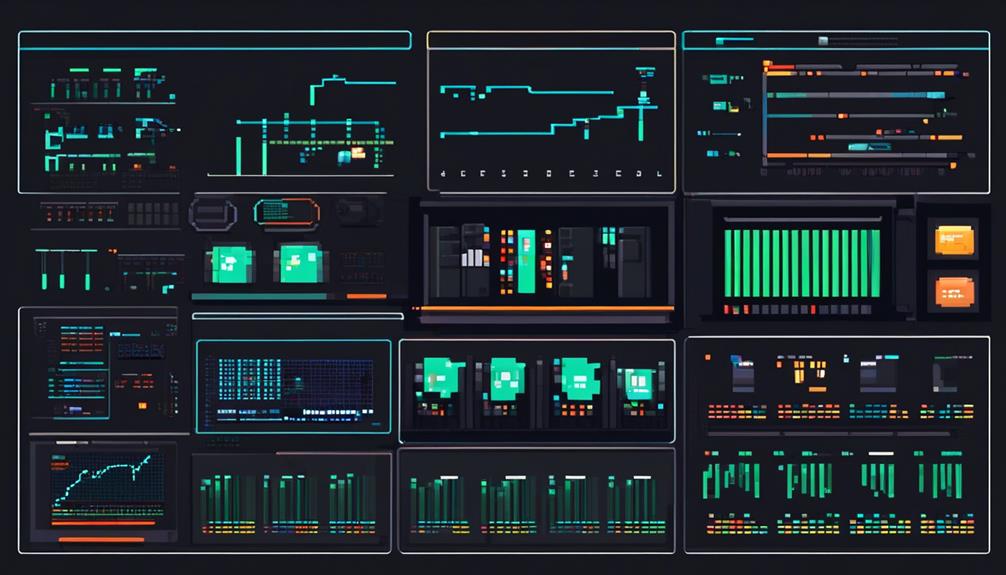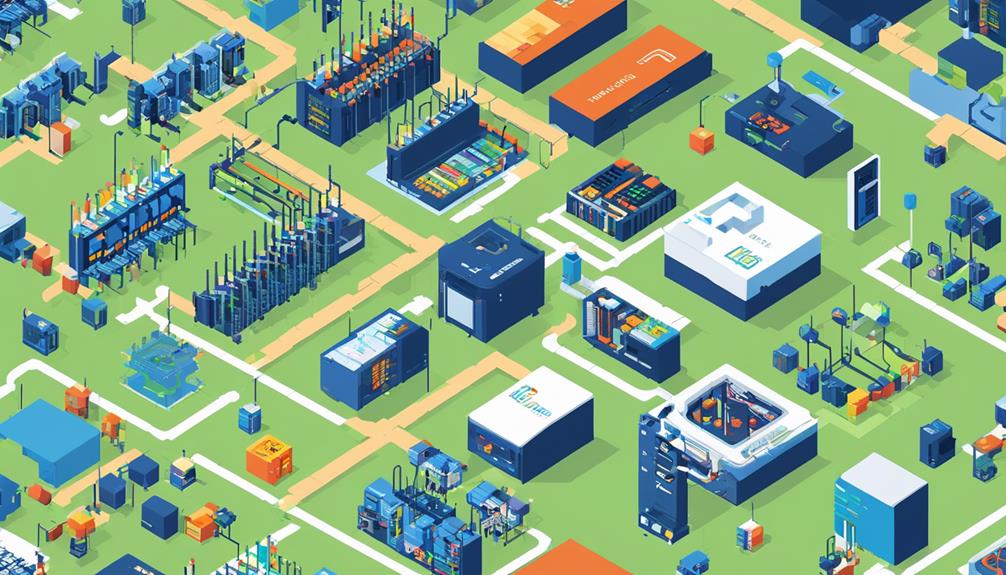Monitoring hardware for cloud operations is a critical aspect of managing and maintaining the performance and security of cloud services. With the increasing reliance on cloud infrastructure, organizations need to ensure that their hardware components, such as networks, servers, and storage systems, are continuously monitored to identify any potential issues or vulnerabilities.
This discussion aims to explore the purpose of monitoring hardware in the cloud, the essential components to monitor, the available tools and technologies, and best practices to ensure efficient and effective hardware monitoring.
By understanding the importance of monitoring hardware in cloud operations, organizations can proactively address any issues, optimize resource usage, and ensure the smooth and reliable functioning of their cloud-based applications and services.
Key Takeaways
- Monitoring hardware in cloud operations optimizes resource usage and detects errors for prompt troubleshooting.
- It provides visibility into the complete infrastructure and tracks the performance of cloud applications and infrastructure.
- Monitoring hardware enables proactive maintenance, minimizes disruption to cloud services, and enhances trust in the cloud service provider.
- Essential hardware components in cloud operations include servers, storage devices, networking equipment, physical security devices, and metrics/logs.
Purpose of Monitoring Hardware

Monitoring hardware in cloud operations serves several key purposes. Firstly, it aims to optimize resource usage within the cloud infrastructure. By continuously monitoring the hardware, organizations can identify any bottlenecks or areas of inefficiency and take appropriate action to rectify them.
Additionally, hardware monitoring plays a crucial role in detecting errors within the cloud infrastructure, allowing for prompt troubleshooting and resolution.
Furthermore, monitoring hardware provides visibility into the complete infrastructure, both in public clouds and private data centers. This visibility is essential for efficient management of cloud resources. It enables organizations to track the performance of their cloud applications and infrastructure, ensuring they meet the desired performance standards. By collecting and analyzing performance metrics, organizations can identify areas for improvement and optimize their cloud operations accordingly.
To enable effective hardware monitoring, various tools are available in the market. These tools, such as NetApp Cloud Insights and Amazon CloudWatch, offer native cloud integration and scalability. They provide comprehensive monitoring capabilities, allowing organizations to monitor their cloud resources and applications in real-time. Additionally, these tools often come with built-in dashboards and alerts, enabling organizations to stay informed about the performance of their cloud infrastructure.
Essential Hardware Components
To ensure smooth and efficient cloud operations, it is crucial to understand the key hardware components involved. These components include servers, storage devices, networking equipment, and power systems.
Servers play a critical role in processing and storing data, while storage devices are essential for data retention and access.
Networking equipment facilitates communication and data transfer, while power systems ensure continuous operation and prevent data loss.
Understanding and monitoring these essential hardware components is vital for maintaining optimal performance and reliability in cloud environments.
Key Hardware Components
Key hardware components are crucial for the optimal performance of infrastructure in cloud operations. These components include servers, storage devices, networking equipment, and physical security devices.
Here are 5 essential hardware components for cloud operations:
- Servers: Servers play a critical role in hosting and processing cloud resources and applications. Monitoring tools can provide insights into server performance, resource utilization, and potential bottlenecks.
- Storage Devices: Storage devices, such as hard drives and solid-state drives, are responsible for storing and retrieving data in cloud environments. Monitoring storage capacity, latency, and throughput can ensure efficient data storage and retrieval.
- Networking Equipment: Networking equipment, such as routers, switches, and firewalls, enable data communication and ensure the security of cloud infrastructure. Network monitoring solutions help detect network congestion, latency issues, and potential security breaches.
- Physical Security Devices: Physical security devices, including surveillance cameras and access control systems, safeguard the physical infrastructure of cloud operations. Monitoring these devices ensures the protection of critical hardware components.
- Metrics and Logs: Monitoring tools collect and analyze metrics and logs from hardware components to identify performance issues, optimize resource allocation, and troubleshoot problems in the cloud environment.
Monitoring Best Practices
Monitoring best practices for essential hardware components in cloud operations involve implementing robust monitoring tools and strategies to ensure optimal performance, scalability, and security. By utilizing reliable monitoring tools, organizations can gain visibility into their cloud infrastructure, applications, and services, enabling proactive detection of issues and prompt resolution. A variety of cloud monitoring tools are available that cater to different needs, including open-source options and commercial solutions. These tools provide comprehensive monitoring capabilities, enabling organizations to monitor their hybrid cloud environments, track resource utilization, and conduct root cause analysis for troubleshooting. Additionally, implementing an observability platform can enhance monitoring capabilities by aggregating and analyzing data from various sources, allowing for better understanding of system behavior and performance. By following monitoring best practices, organizations can ensure the smooth operation of their cloud infrastructure, mitigate risks, and optimize resource allocation.
| Monitoring Best Practices for Essential Hardware Components |
|---|
| Monitoring Tools |
| – Utilize a range of cloud monitoring tools available in the market, including open-source and commercial solutions. |
| – Choose tools that offer comprehensive monitoring capabilities for cloud infrastructure, applications, and services. |
| Hybrid Cloud Environments |
| – Ensure that monitoring tools are capable of monitoring both on-premises and cloud-based resources in hybrid cloud environments. |
| – Leverage tools that provide seamless integration with popular cloud platforms and APIs. |
| Cloud Infrastructure Monitoring |
| – Monitor essential hardware components such as servers, storage devices, and networking equipment for performance and availability. |
| – Set up alerts and notifications to promptly identify and address any issues or anomalies. |
| Root Cause Analysis |
| – Implement tools that enable root cause analysis to identify the underlying causes of performance degradation or service disruptions. |
| – Use data-driven insights to optimize resource allocation and improve overall system efficiency. |
Network Monitoring Tools

Network monitoring tools are essential for ensuring the optimal performance and reliability of network infrastructure in cloud operations. These tools provide real-time visibility into network health and performance, allowing for the identification and resolution of issues such as bandwidth congestion, latency, and packet loss.
Key features of network monitoring tools include tracking network device availability, response time, traffic patterns, and network security, making them indispensable for maintaining a secure and efficient cloud network environment.
Top Network Monitoring Tools
NetApp Cloud Insights, Google Operations, Microsoft Azure Monitor, Amazon CloudWatch, and Oracle Application Performance Monitoring are among the top network monitoring tools available for cloud operations.
These cloud monitoring tools provide comprehensive monitoring services to ensure the performance and availability of network resources in a cloud environment.
- NetApp Cloud Insights offers visibility into the complete infrastructure, allowing organizations to identify and address any potential issues promptly.
- Google Operations is a powerful tool for monitoring Google Cloud Platform, providing built-in dashboards and alerts to help organizations monitor and optimize their cloud performance.
- Microsoft Azure Monitor collects metrics and logs, integrates with Event Hubs and Logic Apps, and offers analytics and machine learning tools for efficient monitoring and troubleshooting.
- Amazon CloudWatch is an AWS monitoring service that integrates with over 70 AWS services, allowing organizations to monitor their cloud resources and trigger automated actions through CloudWatch Events.
- Oracle Application Performance Monitoring is a vendor-agnostic tool that monitors browser, application, and resource performance across different cloud environments, ensuring optimal user experience.
Key Features for Monitoring
As we continue our exploration of network monitoring tools for cloud operations, let us now turn our attention to the key features that make these tools essential for efficient monitoring and management.
When it comes to monitoring tools for cloud operations, there are several key features that are crucial for effective network monitoring. First and foremost, real-time visibility is of utmost importance. These tools provide real-time insights into the performance of network resources and applications, enabling administrators to detect and address issues promptly.
Another important feature is scalability, as cloud environments are dynamic and constantly evolving. The best cloud monitoring tools offer the ability to scale and adapt to the changing needs of the network infrastructure.
Integration and compatibility are also critical, as these tools should support diverse network devices and protocols for comprehensive monitoring. Additionally, alerting and reporting capabilities are essential, allowing administrators to receive alerts for network issues and generate detailed reports for performance analysis and troubleshooting.
Lastly, a user-friendly interface is paramount, as it enables efficient network monitoring and management. By incorporating these key features, cloud monitoring tools assist organizations in effectively monitoring their hybrid cloud infrastructure, ensuring the optimal performance of their cloud services across different cloud platforms.
Benefits of Network Monitoring
Effective network monitoring tools provide real-time visibility into network performance, enabling proactive issue resolution and optimization of resources. These tools help businesses in various ways, including:
- Identifying and resolving network bottlenecks, ensuring efficient resource utilization and improved user experience.
- Detecting security threats and vulnerabilities, contributing to enhanced data and infrastructure security.
- Monitoring and analyzing network traffic and performance, supporting informed decision-making and operational efficiency.
- Offering built-in alerting and reporting features, allowing prompt responses to network issues and ensuring continuous network availability.
- Enabling businesses to leverage cloud-based network monitoring tools, reducing the cost and complexity of managing on-premises infrastructure.
Server Monitoring Tools

Server monitoring tools are crucial for maintaining the performance, security, and availability of server infrastructure. These tools provide organizations with the necessary monitoring capabilities to optimize resource usage, identify bottlenecks, and detect errors in server performance. By leveraging server monitoring tools, businesses can ensure that their infrastructure is operating at optimal levels, maximizing efficiency and minimizing downtime.
One of the key advantages of server monitoring tools is their ability to enable cost monitoring. These tools allow businesses to closely monitor resource usage and identify underutilized services, leading to potential cost savings. By analyzing resource usage patterns, organizations can make informed decisions about resource allocation and identify areas where resources can be scaled back or reallocated.
In addition to optimizing resource usage, server monitoring tools play a crucial role in security monitoring. They help ensure that data and applications are secure, compliant, and protected against threats. By monitoring server behavior and detecting any anomalies or suspicious activities, these tools contribute to the overall security posture of the infrastructure.
Server monitoring tools also facilitate infrastructure management by providing insights into the overall health and performance of the server environment. They help identify outages, detect vulnerabilities, and contribute to improved operational efficiency and reliability. With the ability to monitor server metrics in real-time, organizations can proactively address any issues before they impact the end-user experience.
When considering server monitoring tools, organizations have the option to choose from a variety of open-source and commercial options. Open-source tools offer flexibility and customization options, while commercial tools provide additional features and support. Ultimately, the choice of server monitoring tool depends on the specific requirements and goals of the organization.
Storage Monitoring Tools
Storage monitoring tools are essential for tracking the performance metrics of storage resources in cloud environments. These tools provide real-time data monitoring, enabling administrators to monitor storage capacity, I/O performance, latency, and identify potential bottlenecks.
Additionally, they feature alert and notification systems to proactively address any storage issues and ensure efficient utilization of storage resources.
Performance Metrics Tracking
Performance metrics tracking tools for storage systems are essential for optimizing resource utilization and identifying bottlenecks. These tools collect and analyze data related to storage performance, including throughput, latency, and IOPS (Input/Output Operations Per Second).
Storage monitoring tools offer visibility into storage capacity, usage patterns, and trends to ensure efficient resource allocation and prevent storage overruns. They provide real-time alerts and notifications for potential storage-related issues and anomalies, enabling proactive troubleshooting and maintenance.
By monitoring key performance metrics, these tools help end users improve storage performance, reliability, and cost-effectiveness.
Some of the top cloud monitoring tools include Datadog, New Relic, and Dynatrace. These tools have a wide range of capabilities and collect data from various sources to provide comprehensive insights into storage performance.
Real-Time Data Monitoring
Real-time data monitoring tools play a crucial role in ensuring the seamless performance and efficient utilization of storage systems. These tools provide immediate visibility into storage performance and usage, continuously monitoring data storage systems to detect and address issues as they occur.
By offering insights into data throughput, latency, IOPS, and capacity utilization in real-time, storage monitoring tools enable proactive management of storage resources and help prevent potential bottlenecks and downtime. They contribute to optimizing storage infrastructure and ensuring efficient data access and retrieval.
Real-time data monitoring tools are essential in the context of cloud monitoring, as they allow for the continuous monitoring of storage platforms, applications, and services. They also play a vital role in enhancing security through threat detection and employing machine learning algorithms to identify and respond to potential security breaches.
Alert and Notification Systems
As we shift our focus to the realm of storage monitoring tools, a crucial aspect to consider is the implementation of alert and notification systems. These systems play a vital role in ensuring the smooth operation of cloud environments by providing real-time detection and response to potential issues.
Here are five key benefits of incorporating alert and notification systems into storage monitoring tools:
- Real-time alerts enable IT teams to monitor storage capacity and quickly address any potential performance degradation or outages.
- Automated notifications facilitate prompt incident management and resolution, minimizing downtime and data loss.
- Alert systems assist in proactive capacity planning by flagging potential storage shortages before they impact operations.
- Integration with alert and notification systems allows for the automation of actions triggered by specific events, streamlining monitoring and troubleshooting processes.
- Overall, the implementation of these systems contributes to improved system reliability and performance in cloud environments.
Security Monitoring Tools
Security monitoring tools are essential for detecting and preventing security threats in cloud environments, ensuring compliance with regulations, and providing real-time threat detection. These tools play a crucial role in ensuring the security of data and infrastructure in cloud environments.
Cloud security is a top priority for organizations, as they store sensitive data and applications in the cloud. Monitoring cloud apps for security threats is necessary to identify and mitigate any potential risks. Security monitoring tools offer features such as real-time monitoring for security threats, integration with existing Security Information and Event Management (SIEM) systems, and protection against cyberattacks.
One of the key benefits of security monitoring tools is their ability to monitor both the infrastructure and application layers of a cloud environment. This allows organizations to detect and respond to security incidents at various levels, ensuring comprehensive protection. By continuously monitoring the cloud environment, these tools can identify any unusual activities or anomalies that may indicate a security breach or vulnerability.
In addition to threat detection, security monitoring tools also provide alerts and notifications for potential security breaches. This enables organizations to take immediate action and minimize the impact of any security incidents. By receiving real-time alerts, organizations can proactively respond to threats and prevent any potential damage.
Moreover, security monitoring tools also contribute to cost optimization in cloud computing. By identifying security vulnerabilities and addressing them promptly, organizations can avoid costly security breaches and their associated financial and reputational consequences.
Performance Monitoring Tools

Performance monitoring tools play a crucial role in optimizing resource usage, identifying bottlenecks, and detecting errors in cloud operations. These tools help organizations in various ways, including:
- Cost optimization: Performance monitoring tools assist in identifying underutilized services and optimizing resource usage. By monitoring performance metrics, organizations can gain insights into areas where resource allocation can be optimized, thus reducing cost per feature.
- Improved application performance: Application Performance Management (APM) tools help in tracking and analyzing application performance in real-time. These tools monitor response times, transaction rates, and error rates, enabling organizations to identify and resolve performance issues quickly.
- Multi-cloud compatibility: Performance monitoring tools are designed to work in multi-cloud environments, where organizations use multiple public clouds simultaneously. These tools provide a unified view of performance metrics across different cloud platforms, facilitating efficient management and troubleshooting.
- Visibility and troubleshooting: Performance monitoring tools provide visibility into the performance of public clouds and private data centers. They monitor and analyze performance metrics, such as CPU utilization, network latency, and disk I/O, enabling organizations to troubleshoot issues and optimize infrastructure for improved performance.
- Open-source cloud monitoring: Open-source performance monitoring tools offer flexibility and cost-effectiveness. They provide organizations with the ability to customize and extend the monitoring capabilities as per their specific requirements, without the need for vendor lock-in.
Capacity Planning Tools
Capacity planning tools facilitate efficient resource allocation and forecasting for optimal infrastructure performance. These tools play a crucial role in helping organizations plan and manage their cloud resources effectively, ensuring that they have the right amount of resources available to meet the demands of their workloads. By analyzing historical data and usage patterns, capacity planning tools can forecast future resource requirements and help organizations avoid under-provisioning or over-provisioning of resources.
To provide a deeper understanding of the capabilities of capacity planning tools, the following table highlights some popular tools in this category:
| Capacity Planning Tool | Key Features | Supported Platforms |
|---|---|---|
| SolarWinds Network Performance Monitor | Provides real-time visibility into network performance, capacity forecasting, and resource utilization. | Windows |
| Azure Monitor | Offers comprehensive monitoring and insights for Azure resources, including capacity planning. | Microsoft Azure |
| Nagios Core | Monitors and alerts on system resources, allowing for capacity planning and optimization. | Multiple platforms |
These tools enable organizations to visualize their system's performance and utilization trends, allowing them to make informed decisions regarding scaling and resource allocation. By identifying potential bottlenecks and planning for infrastructure growth, capacity planning tools help optimize resource allocation and reduce cloud costs.
Fault Detection and Resolution Tools

Fault detection and resolution tools play a critical role in ensuring the reliability and availability of cloud services by identifying and addressing system failures and errors. These tools enable proactive monitoring to detect and respond to potential faults before they impact performance. By providing real-time alerts and notifications, fault detection and resolution tools facilitate prompt resolution of issues in the cloud infrastructure. Their contribution to maintaining high availability and reliability of cloud services and applications cannot be overstated.
Here are five reasons why these tools are essential in cloud operations:
- Minimize downtime: Fault detection and resolution tools aid in minimizing downtime by quickly identifying and resolving issues. This ensures that cloud services remain accessible and operational, minimizing the impact on users and business operations.
- Optimize performance: These tools help optimize the performance of cloud resources by effectively managing faults. By addressing issues promptly, they prevent performance degradation and maintain the desired levels of service quality.
- Enhance resource utilization: Through continuous monitoring, fault detection and resolution tools provide insights into resource utilization patterns. This information enables efficient allocation and utilization of cloud resources, leading to cost savings and improved overall performance.
- Improve customer satisfaction: By proactively identifying and resolving faults, these tools contribute to improved customer satisfaction. Customers can rely on the cloud service provider's ability to deliver uninterrupted services, enhancing their trust and confidence.
- Enable proactive maintenance: Fault detection and resolution tools enable proactive maintenance by identifying potential issues in the cloud infrastructure. This helps prevent catastrophic failures and allows for planned maintenance activities, minimizing disruption to cloud services.
Real-time Alerting Tools
Real-time alerting tools serve as indispensable components in cloud operations by providing immediate notifications about performance, security, or availability issues in cloud services and applications. These tools offer instant alerts for critical events, allowing rapid response to potential problems and threats. By leveraging real-time alerting tools, organizations can ensure that their cloud environments are closely monitored and any issues are promptly addressed.
One of the key benefits of real-time alerting tools is their ability to provide continuous monitoring and immediate awareness of any anomalies or deviations from expected performance or behavior. These tools enable proactive monitoring and action by allowing users to customize notifications based on specific thresholds or conditions. This ensures that potential issues are detected and addressed before they escalate into major problems.
Real-time alerting tools play a crucial role in maintaining the operational integrity of cloud environments. They facilitate quick identification and resolution of issues, minimizing any negative impact on the performance, security, or availability of cloud services and applications. Organizations can rely on these tools to receive real-time notifications about any abnormalities in their cloud operations, allowing them to take immediate action to mitigate risks and ensure optimal performance.
To effectively utilize real-time alerting tools, organizations need to have the necessary monitoring hardware in place. This hardware is responsible for collecting and analyzing the necessary data to trigger alerts. It plays a vital role in ensuring that the real-time alerting tools have access to accurate and up-to-date information for effective monitoring.
Data Visualization and Reporting Tools

Data visualization and reporting tools play a crucial role in monitoring hardware for cloud operations. These tools allow users to visualize real-time data, providing a clear and concise overview of system performance.
With customizable reporting options, users can generate tailored reports to analyze trends and make informed decisions.
Visualizing Real-Time Data
Visualizing real-time data is crucial for gaining insights and making informed decisions in cloud operations. Data visualization tools play a significant role in this process by providing the means to create graphical representations of real-time data.
Here are five key reasons why visualizing real-time data is essential for effective cloud operations management:
- Enhanced understanding: Visualizations enable users to comprehend complex data quickly and intuitively, allowing them to identify patterns and trends.
- Improved decision-making: Real-time visualizations provide instant access to critical metrics and insights, enabling prompt decision-making.
- Customization and configuration: Data visualization tools offer the flexibility to customize and configure visualizations based on specific data requirements and objectives.
- Comprehensive monitoring: These tools can visualize and report on diverse data sources, ensuring comprehensive monitoring and analysis of cloud operations.
- Visual appeal: Visualizations present data in an aesthetically pleasing manner, making it easier for stakeholders to engage with and understand the information.
Customizable Reporting Options
To facilitate effective cloud operations management, customizable reporting options provided by data visualization and reporting tools play a crucial role in transforming real-time monitoring data into meaningful insights for informed decision-making.
These tools, such as Google Cloud Platform, Amazon Web Services, and New Relic, are designed specifically for monitoring and offer customizable reporting options that allow users to create tailored visualizations and reports based on their specific monitoring needs.
By presenting data in a format that best suits their requirements, users can create detailed and insightful visualizations that can be easily shared and understood.
These customizable reporting options are essential in monitoring cloud costs and identifying areas for optimization, enabling businesses to make informed decisions and effectively manage their cloud operations.
Streamlining Performance Analysis
Streamlining Performance Analysis through the use of data visualization and reporting tools is crucial for optimizing resource allocation and improving overall efficiency in cloud operations management. These tools offer a range of benefits that enable effective monitoring and analysis of cloud infrastructure performance.
Here are five key advantages of using data visualization and reporting tools for performance analysis in cloud operations:
- Identification of performance bottlenecks and errors: These tools help pinpoint areas of the cloud infrastructure that are causing slowdowns or errors, allowing for timely resolution.
- Proactive performance optimization: By analyzing trends and patterns, these tools enable proactive measures to be taken for optimizing performance and preventing issues before they occur.
- Real-time insights: With real-time metrics and visualizations, these tools provide immediate visibility into the performance of hardware and resources, enabling quick decision-making and issue resolution.
- Customizable dashboards and reports: These tools offer customizable dashboards and reports, allowing for comprehensive performance monitoring and reporting tailored to specific needs.
- Efficient resource utilization: By providing insights into resource utilization, these tools enable efficient allocation of resources in the cloud, maximizing performance and minimizing wastage.
Integration With Cloud Service Providers

Integration with cloud service providers facilitates seamless connectivity and data exchange between monitoring tools and the cloud environment. This integration ensures that monitoring tools can access and monitor the resources and services provided by the cloud service provider, such as AWS services or Microsoft Azure. By connecting monitoring tools with the cloud environment, organizations can effectively monitor their cloud infrastructure and gain insights into its performance.
One of the key benefits of integrating monitoring tools with cloud service providers is the ability to leverage the native cloud monitoring capabilities and APIs provided by these providers. This allows organizations to enhance the efficiency and accuracy of their monitoring activities. By utilizing these native capabilities, organizations can collect performance metrics, logs, and other relevant data from the cloud infrastructure for monitoring and analysis.
Additionally, effective integration with cloud service providers enables real-time monitoring, alerting, and management of cloud resources and services from a centralized monitoring platform. This unified infrastructure management tool provides a single pane of glass for monitoring various cloud services and resources. It eliminates the need for multiple tools for monitoring different aspects of the cloud environment, streamlining the monitoring process and improving operational efficiency.
Furthermore, integrating monitoring tools with cloud service providers allows organizations to take advantage of the extensive ecosystem of tools for monitoring and managing cloud services. These tools provide advanced features and functionalities to monitor and analyze cloud resources, ensuring optimal performance and availability.
Scalability and Flexibility Considerations
Scalability and flexibility are critical considerations when evaluating monitoring tools for cloud operations. The dynamic nature of cloud operations requires monitoring hardware that can scale with the infrastructure and adapt to changing needs. Here are some key factors to consider:
- Capacity to handle increasing data volumes: As the volume of data generated by cloud operations continues to grow, monitoring tools must be able to scale their processing power and storage capacity to handle the increased workload. This ensures that all relevant data is captured and analyzed effectively.
- Flexible deployment options: Cloud environments can vary significantly, with different architectures and service providers being utilized. Monitoring tools should offer flexible deployment options that can adapt to these diverse environments, allowing for seamless integration and monitoring across the entire infrastructure.
- Accommodation of infrastructure changes: Cloud environments are highly dynamic, with infrastructure changes occurring frequently. Monitoring hardware should be able to accommodate these changes and automatically adjust its monitoring capabilities accordingly. This ensures that monitoring remains accurate and effective, even as the infrastructure evolves.
- Adaptability to different cloud environments: Businesses often utilize multiple cloud service providers or hybrid cloud environments. Monitoring tools should be able to adapt to these different environments, providing consistent monitoring across all platforms and ensuring comprehensive visibility into cloud operations.
- Scalability to meet evolving business needs: As businesses grow and their cloud operations expand, monitoring tools should be able to scale alongside the infrastructure. This scalability ensures that monitoring remains effective and efficient, even as the workload and complexity of cloud operations increase.
Considering these scalability and flexibility considerations is vital when selecting monitoring hardware for cloud operations. By choosing tools that can handle increasing data volumes, offer flexible deployment options, accommodate infrastructure changes, adapt to different cloud environments, and scale alongside business needs, organizations can ensure efficient and comprehensive monitoring of their cloud operations.
Best Practices for Hardware Monitoring in the Cloud

To ensure efficient and effective hardware monitoring in the cloud, organizations should establish clear performance, security, and availability monitoring metrics for their cloud services and applications. By implementing best practices for hardware monitoring, organizations can optimize resource usage, maintain performance, ensure compliance, detect threats, and proactively manage their cloud infrastructure.
One best practice is to regularly optimize resource usage by monitoring the performance of cloud services and applications. This involves identifying underutilized services and reallocating resources to improve efficiency. By monitoring resource usage, organizations can detect errors and bottlenecks, enabling them to take corrective actions and maintain optimal performance.
Another crucial best practice is to implement robust security monitoring in the cloud. This involves monitoring access controls, data encryption, and vulnerability scanning to ensure compliance with security standards. By continuously monitoring security, organizations can detect and respond to threats promptly, safeguarding their data and applications in the cloud.
Cloud monitoring is also essential for proactive management of hardware in the cloud. This practice involves utilizing monitoring tools to optimize infrastructure, identify outages, and detect vulnerabilities. By monitoring the health and performance of hardware components, organizations can take preventive measures to mitigate potential issues and minimize downtime.
To gain comprehensive visibility into the complete infrastructure, organizations should integrate native cloud monitoring tools. These tools allow organizations to troubleshoot issues, improve performance, and optimize billing by monitoring resource utilization and costs. By leveraging these tools, organizations can make informed decisions and ensure the efficient operation of their hardware in the cloud.
The table below summarizes the best practices for hardware monitoring in the cloud:
| Best Practices for Hardware Monitoring in the Cloud |
|---|
| Regularly optimize resource usage |
| Implement robust security monitoring |
| Utilize cloud monitoring for proactive management |
| Integrate native cloud monitoring tools |
Frequently Asked Questions
How Do I Monitor My Cloud Services?
To effectively monitor your cloud services, it is crucial to utilize tools specifically designed for cloud service monitoring. These tools enable you to track key metrics such as performance, availability, and security.
Best practices include setting up automation and alerting mechanisms to promptly address any issues. Monitoring complex cloud architectures can be challenging, but real-time visibility allows you to identify and resolve problems quickly.
Additionally, efficient cloud service monitoring helps optimize costs by identifying underutilized resources and optimizing resource usage.
Which of the Following Monitoring Devices Is Used in Cloud Computing?
Performance monitoring, resource utilization, security monitoring, incident management, cost optimization, scalability monitoring, and data analytics are all essential aspects of monitoring in cloud computing.
However, the question specifically asks about monitoring devices used in cloud computing. While there are various monitoring tools and services available, the question does not specify any particular devices.
Therefore, it is important to note that monitoring in cloud computing typically involves the use of software-based solutions rather than specific hardware devices.
What Is Cloud Based Monitoring System?
A cloud-based monitoring system is a software solution that ensures the performance, security, and availability of cloud services and applications. It offers various benefits such as optimized resource usage, identification of bottlenecks and errors, and enhanced performance.
Key features include:
- Infrastructure monitoring
- Outage identification
- Vulnerability detection
- Data and application security
- Compliance enforcement
- Threat detection
- Cost optimization
Implementing a cloud-based monitoring solution can pose challenges, but following best practices and choosing the right tools can help overcome them.
Real-world use cases demonstrate the effectiveness of cloud-based monitoring in action.
How Can You Best Monitor the Cloud Network?
When it comes to monitoring a cloud network, there are several best practices to consider.
Firstly, it is important to utilize top cloud monitoring tools that provide comprehensive visibility into the network's performance, security, and availability.
Key metrics to monitor include resource utilization, network latency, and application response times.
Real-time monitoring is crucial in cloud operations to quickly detect and address any issues.
Artificial intelligence plays a role in enhancing cloud network monitoring by automating analysis and providing predictive insights.
Cloud network monitoring differs from traditional network monitoring in terms of scalability, flexibility, and the need for specialized tools and techniques.

